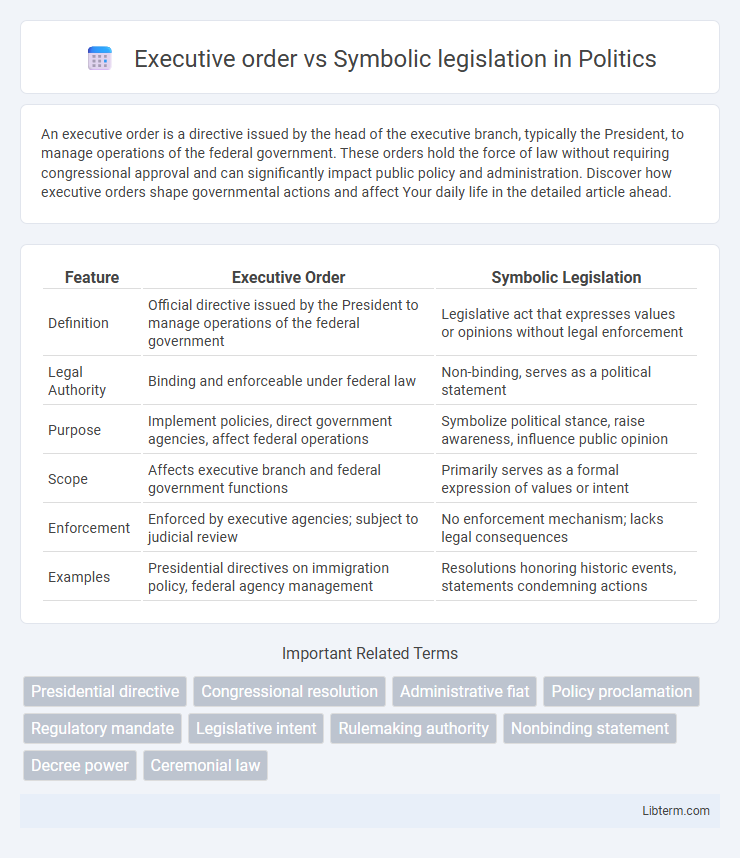An executive order is a directive issued by the head of the executive branch, typically the President, to manage operations of the federal government. These orders hold the force of law without requiring congressional approval and can significantly impact public policy and administration. Discover how executive orders shape governmental actions and affect Your daily life in the detailed article ahead.
Table of Comparison
| Feature | Executive Order | Symbolic Legislation |
|---|---|---|
| Definition | Official directive issued by the President to manage operations of the federal government | Legislative act that expresses values or opinions without legal enforcement |
| Legal Authority | Binding and enforceable under federal law | Non-binding, serves as a political statement |
| Purpose | Implement policies, direct government agencies, affect federal operations | Symbolize political stance, raise awareness, influence public opinion |
| Scope | Affects executive branch and federal government functions | Primarily serves as a formal expression of values or intent |
| Enforcement | Enforced by executive agencies; subject to judicial review | No enforcement mechanism; lacks legal consequences |
| Examples | Presidential directives on immigration policy, federal agency management | Resolutions honoring historic events, statements condemning actions |
Definition of Executive Orders
Executive orders are legally binding directives issued by the President of the United States to manage operations of the federal government without requiring congressional approval. They have the force of law and are used to implement policies, direct government agencies, or clarify existing statutes. Symbolic legislation, in contrast, represents laws passed primarily to express values or political statements without significant practical impact or enforcement mechanisms.
Understanding Symbolic Legislation
Symbolic legislation serves primarily to express values or signal a government's stance without enacting significant legal change or enforcement mechanisms. Unlike executive orders, which have immediate legal authority and direct administrative impact, symbolic laws function as political statements to influence public opinion or demonstrate commitment to certain issues. Understanding symbolic legislation involves recognizing its role in agenda-setting and public discourse rather than practical governance.
Legal Authority and Enforcement
Executive orders derive their legal authority directly from the president's constitutional powers or specific congressional statutes, allowing immediate enforcement without requiring congressional approval. Symbolic legislation, while passed by Congress, often lacks binding enforcement mechanisms and primarily serves as a formal expression of policy or values rather than actionable law. Enforcement of executive orders is overseen by executive agencies, whereas symbolic legislation typically does not mandate executive action or regulatory implementation.
Historical Examples of Executive Orders
Executive orders have been pivotal in shaping U.S. policy directly through presidential authority, with notable historical examples including Franklin D. Roosevelt's Executive Order 9066, which authorized Japanese American internment during World War II, and Harry S. Truman's Executive Order 9981, which desegregated the armed forces. Unlike symbolic legislation that primarily holds rhetorical value without enforceable power, executive orders carry immediate legal effect, often addressing urgent issues bypassing congressional delays. These historical directives underscore executive orders' significant role in implementing substantial policy changes during critical moments in American history.
Notable Instances of Symbolic Legislation
Symbolic legislation serves primarily to express values or public sentiment without creating enforceable laws, often used to signal government priorities or cultural recognition. Notable instances include the 2009 Matthew Shepard and James Byrd Jr. Hate Crimes Prevention Act, which symbolized a commitment to combating hate crimes even as its enforcement mechanisms remain debated. Another example is the 1995 National Defense Authorization Act's section designations used to honor military figures, reflecting symbolic legislative intent beyond policy changes.
Impact on Policy Implementation
Executive orders enable rapid policy implementation by allowing the president to direct government agencies without awaiting legislative approval, resulting in immediate administrative action. Symbolic legislation primarily serves to communicate political values or public sentiment, often lacking enforceable mechanisms, thus having limited direct impact on policy execution. The distinction significantly affects the speed and effectiveness with which government policies are enacted and enforced.
Public Perception and Political Messaging
Executive orders provide a direct, authoritative method for leaders to enact policy changes swiftly, often perceived by the public as decisive government action. Symbolic legislation, while sometimes lacking immediate practical effect, serves as a strategic tool to communicate values and political priorities, resonating emotionally with constituents. Public perception of executive orders tends to focus on efficiency and leadership strength, whereas symbolic legislation shapes political messaging by signaling commitment to key issues without contentious policy shifts.
Checks and Balances: Legal Limitations
Executive orders are directives issued by the President that carry the force of law but are subject to judicial review and Congressional oversight, ensuring checks and balances through legal limitations. Symbolic legislation primarily serves as a formal expression of intent or values without binding legal effects, allowing Congress to influence public policy while avoiding executive enforcement constraints. Courts can invalidate executive orders exceeding presidential authority, while symbolic laws depend on legislative consensus but lack enforcement mechanisms, maintaining equilibrium among branches.
Executive Orders vs Symbolic Legislation: Key Differences
Executive orders are legally binding directives issued by the President to manage operations of the federal government, carrying the force of law without requiring congressional approval. Symbolic legislation, on the other hand, serves primarily to express governmental values or positions without creating enforceable legal obligations or significant policy changes. The key difference lies in executive orders' immediate legal impact and operational authority, contrasted with symbolic legislation's emphasis on public messaging and political symbolism.
Current Trends and Future Outlook
Executive orders have increasingly become tools for swift policy implementation amid legislative gridlock, particularly in areas like climate change and immigration, reflecting a trend toward executive activism. Symbolic legislation continues to serve as a political statement to signal intent or address public sentiment without immediate legal impact. Future outlook suggests executive orders will maintain prominence in shaping policy during divided government, while symbolic bills may evolve to shape future legislative agendas and public discourse.
Executive order Infographic

 libterm.com
libterm.com